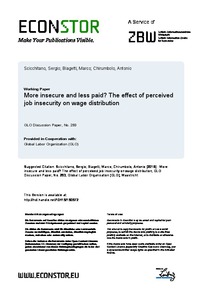More insecure and less paid? The effect of perceived job insecurity on wage distribution
"This article employs a Counterfactual Decomposition Analysis (CDA) using both a semi-parametric and a non-parametric method to examine the pay gap, over the entire wage distribution, between secure and insecure workers on the basis of perceived job insecurity. Using the 2015 INAPP Survey on Qu...
| Main Authors: | , , |
|---|---|
| Institution: | ETUI-European Trade Union Institute |
| Format: | TEXT |
| Language: | English |
| Published: |
Leibniz
2018
ZBW |
| Subjects: | |
| Online Access: | https://www.labourline.org/KENTIKA-19306057124911242399-More-insecure-and-less-paid?-T.htm |
| Summary: | "This article employs a Counterfactual Decomposition Analysis (CDA) using both a semi-parametric and a non-parametric method to examine the pay gap, over the entire wage distribution, between secure and insecure workers on the basis of perceived job insecurity. Using the 2015 INAPP Survey on Quality of Work, our results exhibit a mirror J-shaped pattern in the pay gap, with a significant sticky floor effect, i.e. the job insecurity more relevant at the lowest quantiles. This pattern is mainly due to the characteristics effect, while the relative incidence of the coefficient component accounts roughly for 22 up to 36% of the total difference, being more relevant at the bottom of the wage distribution." |
|---|---|
| Physical Description: | 34 p. Digital |

